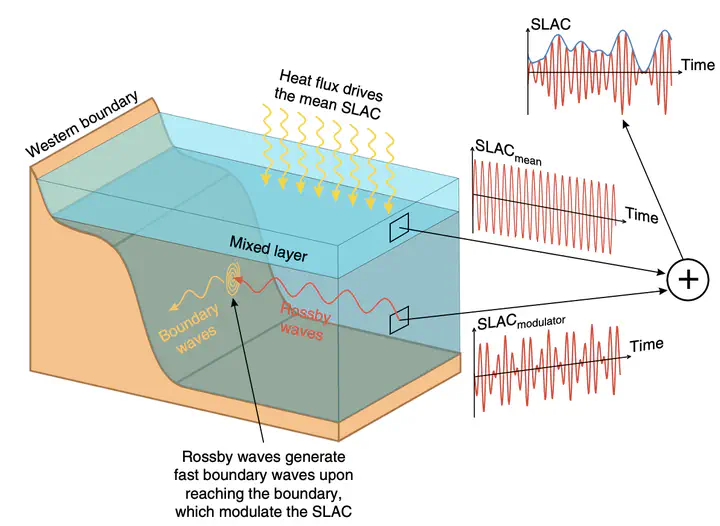Coherent modulation of the sea-level annual cycle in the United States by Atlantic Rossby waves
 Schematic illustration of the mechanism of SLAC (sea-level annual cycle) modulation. The mean SLAC is associated with steric changes in the seasonal thermocline induced by variations in surface heat fluxes, whereas its modulation is related to density anomalies in deeper layers propagating westward as Rossby waves. These Rossby waves give rise to fast boundary waves upon impinging on the western boundary, which in turn modulate the SLAC along the Gulf and Southeast coasts and lead to the coherence over large distances along the coast.
Schematic illustration of the mechanism of SLAC (sea-level annual cycle) modulation. The mean SLAC is associated with steric changes in the seasonal thermocline induced by variations in surface heat fluxes, whereas its modulation is related to density anomalies in deeper layers propagating westward as Rossby waves. These Rossby waves give rise to fast boundary waves upon impinging on the western boundary, which in turn modulate the SLAC along the Gulf and Southeast coasts and lead to the coherence over large distances along the coast.Abstract
Changes in the sea-level annual cycle (SLAC) can have profound impacts on coastal areas, including increased flooding risk and ecosystem alteration, yet little is known about the magnitude and drivers of such changes. Here we show, using novel Bayesian methods, that there are significant decadal fluctuations in the amplitude of the SLAC along the United States Gulf and Southeast coasts, including an extreme event in 2008–2009 that is likely (probability ≥68%) unprecedented in the tide-gauge record. Such fluctuations are coherent along the coast but decoupled from deep-ocean changes. Through the use of numerical and analytical ocean models, we show that the primary driver of these fluctuations involves incident Rossby waves that generate fast western-boundary waves. These Rossby waves project onto the basin-wide upper mid-ocean transport (top 1000 m) leading to a link with the SLAC, wherein larger SLAC amplitudes coincide with enhanced transport variability.